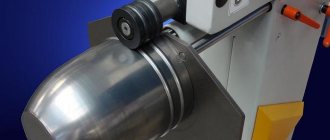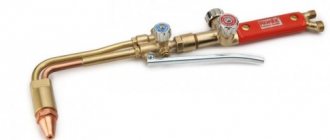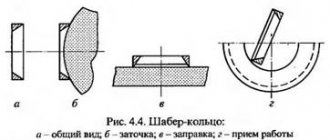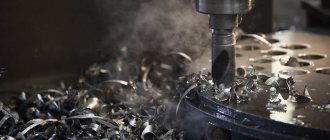The operation of electroplating metals involves applying a thin film of the same material to the surface of a metal product using an electrolyte. During the processing of the part, the molecules of the coating metal are transferred by the conductive solution and penetrate into the top layer of the product. As a result, one metal is introduced into the surface space of another.
As a result, this galvanic method allows metal products to acquire additional hardness, corrosion resistance and wear resistance. Metal with galvanic coating significantly increases its decorative properties.
To carry out the galvanic process, a bath is required, which is the basis of all equipment. A conductive solution is poured into it, into which 2 anodes are placed.
There are equipment lines for galvanizing metals. They are installed in separate workshops. Since the work involves chemical reagents, ventilation is installed in the room.
Despite the complexity of the galvanic process, it is quite well studied. Therefore, it can be carried out at home. In this case, you should remember the basic rule: the total area of the anodes must exceed the same parameter of the workpiece.
Principle
The scheme by which metal electroplating is implemented is quite simple. It includes a product on which a protective coating is applied, a container with an electrolyte solution where the product is placed. The third participant in the process is a metal plate, to which a positive current charge is applied; it acts as an anode; the product placed in the solution becomes a cathode, where a negative charge is applied.
When the electrical network is closed, the metal of the anode (plate) dissolves in the electrolyte and, under the influence of current, rushes to the negatively charged product (cathode), thereby creating a durable coating. An electrolyte is a conductive solution for moving metals from the anode to the cathode. The size of containers (baths) with electrolyte varies, depending on production tasks.
Large products are placed on hangers through which a negative charge is passed; the structure is held suspended in the volume of the bathroom. Small products are galvanized in drum-type baths, where a large number of products are simultaneously galvanized. In this case, a negative charge is applied to a drum rotating in a container with electrolyte, where the anode is inserted.
There are bell-type filling baths, where galvanic coating is simultaneously applied to a large number of very small parts, for example, hardware. Products are poured into the container, the electrolyte composition is poured in, and the anode is installed. The baths are given a slow rotation, during which the products are evenly coated with protective metal.
Methods
The galvanic method of coating products allows you to create a durable protective coating on metals, isolating parts from the aggressive effects of working environments. Insulation can be created from various metals; application is carried out by anodic and cathodic sputtering.
Cathodic coating is characterized by the fact that at the slightest violation of the integrity of the applied layer, the metal underneath is destroyed more intensively, which is facilitated by the coating technology itself. An example of rapid erosion is tinned metal products, where tin serves as an insulating layer.
Anodic electroplating has different characteristics. When conditions arise that threaten corrosion, the galvanic insulation is destroyed and the metal remains intact for a long time. Anodized products are reliably protected from aggressive environments and mechanical damage. The most common type of insulation is galvanizing. The method allows you to preserve all the characteristics of the processed product, its appearance, shape and size.
Goals
Galvanic coatings are divided into several types depending on the purpose of the product:
- Protective and decorative. The purpose of application is to obtain high aesthetic characteristics and protect products from destructive factors.
- Protective. They isolate metal parts from aggressive environments and mechanical damage.
- Special purpose. Galvanic coating is applied to obtain new properties - increased wear resistance, increased hardness characteristics, obtaining magnetic and electrical insulating properties of the finished product. In some cases, galvanization is used to restore the original appearance of a product or after long-term use.
3. Cast iron.
Cast iron is an alloy of iron with a large amount of carbon (at least 2.14%). Carbon imparts hardness but reduces ductility. Depending on the form of graphite and the amount of cementite, white, gray, malleable and high-strength cast iron are distinguished. As a rule, products are made from cast iron by casting. The difficulty in coating cast iron lies in the presence of a casting crust, if it is damaged, it is not possible to obtain a high-quality coating. In addition, due to the high carburization of cast iron, during etching, a lot of iron carbides appear on its surface in the form of powder, making it difficult to obtain a firmly bonded coating. Galvanizing cast iron from alkaline solutions is difficult due to the predominant release of hydrogen rather than zinc.
Types of coatings
The galvanic coating method is implemented by applying various metals to the product, each of them has its own characteristics and purposes in the further operation of the part or object:
- Silver plating – increases aesthetic value, protects against corrosion, improves reflective and conductive characteristics. This type of application is in demand in the production of static relays, contactors, electromagnetic relays, electromagnetic starters, microcircuits and other electronic products.
- Nickel plating is the most popular galvanic coating of steel, copper and aluminum products. The nickel layer reliably protects products or machine parts from rust formed under the influence of the external environment, as well as from types of corrosion resulting from contamination of the working environment by aggressive media - alkalis, acids, salts. Nickel-plated products demonstrate high resistance to severe mechanical damage and abrasion.
- Chrome plating - increases the wear resistance and hardness of anodized surfaces, improves the appearance, and restores damaged parts to their original parameters. Depending on changes in the technological regime, a galvanic coating with different parameters and properties is obtained - matte gray (increased hardness, but low wear resistance), shiny (high wear resistance, hardness), milky plastic (aesthetics, high degree of anti-corrosion protection, low hardness), galvanizing – anti-corrosion treatment of solid steel sheets, car parts, construction and finishing materials.
- Electroplated gold plating - used in jewelry, electronics and other fields. The gold layer gives the parts high reflective properties, aesthetics, protection against corrosion, and increases conductive qualities.
- Copper plating - often used to coat metal to protect against corrosion; copper improves current-conducting qualities; metal with such a coating is often used for the production of electrical conductors used outdoors.
- Brass plating – used to protect steel, aluminum and alloys from corrosion damage. The brass layer provides the necessary adhesion of metal parts to rubber.
- Rhodium plating is a special coating applied to give parts high resistance in chemically aggressive environments and to obtain additional mechanical wear resistance. Rhodium plating also adds decorative value to products and protects silver items from oxidation and dullness.
Regulation of the quality and technological processes of galvanic coating occurs using GOST 9.301-78.
Types of galvanic coatings
The processes of galvanic coating of metal differ in their characteristics depending on the material used. Types of galvanic coatings include:
- chrome plating;
- galvanizing;
- etching;
- gilding and silvering;
- copper plating;
- brass plating;
- aluminum galvanization.
Chrome plating
This is the process of introducing chromium into the surface of a metal using an electrolyte under the influence of current. As a result, the product acquires corrosion resistance to aggressive environments. The hardness of the surface layer increases. Machined parts are used in many industries.
Galvanizing
When galvanizing is carried out, the metal surface is covered with a layer of zinc. The resulting galvanic couple works well in aggressive environments. The service life of such a product depends on the time of destruction of zinc. Until then, the metal inside will not corrode.
Etching
Etching is the electrolytic removal of the surface layer from a product. The procedure is carried out to detect internal defects, eliminate rust or oxides. After such an operation, parts are often subjected to a finishing coating. The processed surfaces of the workpieces mate well with each other.
Gilding and silvering
Gilding and silvering are used in jewelry. The bath is filled with electrolyte, into which the jewelry being processed is placed. Silver or gold ions dissolve in the electrolyte. At the end of the procedure, a thin surface layer of precious metal is formed on the surface of the product.
VIEW pure nickel for electroplating on AliExpress →
Copper plating
Copper plating is an intermediate operation, since such a surface is poorly resistant to corrosion. Over time it oxidizes. Next comes the layering of another coating. Alkaline and acidic compounds are used as electrolytes.
Brass plating
When working, cyanide electrolytes of copper, zinc, sodium or potassium are used. The brass surface is applied to improve decorative qualities. This is especially true for white brass plating. Steel blanks, which are covered with rubber, are also subjected to this treatment.
Aluminum electroplating
Galvanic coatings of aluminum include combinations of:
- copper – nickel – chromium;
- nickel – chromium;
- lead - tin;
- copper - tin;
- brass plating;
- galvanizing
Working with aluminum and its alloys is accompanied by certain difficulties. There is an oxide film on their surfaces, which complicates the galvanization process.
Electroplating of metal products is carried out not only on an industrial scale. Home conditions also allow you to engage in this type of activity. If anyone has experience in conducting such events, please share it in the comments to this article.
Preparatory stage
Electroplating is a multi-level technological process implemented in three main stages (preparation, coating, final processing of the finished product).
Preparing surfaces for further galvanization is the most labor-intensive and critical stage of the entire process. The quality of the resulting protective coating depends on the correctness and sufficiency of its implementation. If there is the slightest trace of grease and oxide film on the metal surface, it will be impossible to obtain a homogeneous continuous protective film - the coating will not be able to penetrate the layers of the base metal, bubbles, tears, etc. may form.
Defects can occur in places where burrs remain, surface unevenness, in places of poorly polished joints, in places that are not sufficiently cleaned of dust. Electroplating requires low surface roughness, thorough cleaning after grinding and mandatory treatment with degreasing agents.
Metal electroplating process
Galvanic processing of metal consists of 3 stages:
- Preparation. This is the most labor-intensive process. If there is grease, burrs or dust on the metal surface, the quality of galvanization will be poor. Products must be processed manually or using a sandblasting machine. If there are residual fats, they should be treated with a chemical solution.
- The process of galvanic processing of metal. The electrolyte is poured into the bath, 2 anodes and the part to be coated are placed in it. The electrolyte is heated using a special device to the temperature specified in the technology. Then the current is turned on, which is controlled by the voltage regulator. The cathode is the part itself. Positively charged ions move through the electrolyte and settle on the negatively charged product, forming a surface layer. The duration of the second stage continues until the surface layer of the metal reaches the required size.
- After the galvanic procedure, the parts require additional processing. It consists of brightening, passivating or oiling the surface. For this purpose, the products are immersed in a special solution with reagents. As a result, a surface film 1 mm thick is formed.
When carrying out the galvanic operation process, there is the concept of material compatibility.
All metals in joints corrode. In some cases, this process is slow. But there are pairs that cannot be combined together. The table gives a clear idea of the compatibility of galvanic pairs.
| Metal | Aluminum | Bronze | Duralumin | Brass | Copper | Nickel | Tin | Tin-lead alloy | Carbon steel and cast iron | Chromium | Zinc |
| Aluminum | + | — | + | — | — | — | — | — | + | — | + |
| Bronze | — | + | — | + | + | + | Soldering | Soldering | — | + | — |
| Duralumin | + | — | + | — | — | — | — | — | + | — | + |
| Brass | — | + | — | + | + | + | Soldering | Soldering | — | + | — |
| Copper | — | + | — | + | + | + | Soldering | Soldering | — | + | — |
| Nickel | — | + | — | + | + | + | Soldering | Soldering | + | Missing data | + |
| Tin | — | Soldering | — | Soldering | Soldering | Missing data | + | + | + | Missing data | + |
| Lead-tin alloy | — | Soldering | — | Soldering | Soldering | Soldering | + | + | + | Missing data | + |
| Carbon steel and cast iron | + | — | + | — | — | + | + | + | + | + | + |
| Chromium | — | + | — | + | + | Missing data | Missing data | Missing data | + | + | + |
| Zinc | + | — | + | — | — | + | + | + | + | + | + |
Types of parts processing
Mechanical processing and achieving ideal smoothness of metal parts is achieved at home by grinding the surface with sandpaper and other abrasives; on an industrial scale, sandblasting, chemical, and automated methods are used to achieve results. At the preparatory stage, parts or individual areas that are not subject to galvanization are insulated.
Depending on the type of metal being applied, different preparations are carried out. Before galvanizing or cadmium plating, the surface of the part to be protected is degreased and pickled. Chrome and nickel plating is preceded by mechanical grinding, degreasing, and removal of the oxide film. Degreasing is carried out in two stages - starting work and complete degreasing.
The parts are first washed with solvents - white spirit, gasoline, special organic mixtures, etc. The final treatment is carried out using alkaline solutions or the electrochemical method. After which the parts are washed with hot water, the metal is activated and lightly etched to remove the smallest films of oxides, which improves the adhesion of the surface of the part with the galvanized metal coating.
Materials and equipment used
For all types of metal galvanization, the same type of galvanic equipment is used.
The container into which metal products are immersed is called a bath. The difference is observed only in the type of electrolyte. The exception is cold galvanizing performed by Galvonol. This is a liquid suspension that is directly applied to the metal. It is unstable to some solvents and therefore requires a topcoat.
There are several groups of galvanic baths:
- Large ones. Designed for large-sized products.
- Average. They cannot accommodate a large product. At the same time, they remain the most in demand in conditions of medium-scale production.
- Small ones. They can only galvanize small parts.
Anode plates are placed in the bath. They are made from different materials. Their main task is to replenish the lost metal from the product during the galvanization process.
Important components are the type of electrolyte and current density. These parameters vary depending on the type of operation.
The compositions of cyanide baths for silver plating are presented in the table.
| Compound | Electrolyte number | |||
| 1 | 2 | 3 | 4 | |
| Cyanide silver | 2 | 6 | 30 | 100 |
| Sodium cyanide | 70 | 70 | — | — |
| Potassium cyanide | — | — | 70 | 100 |
| Sodium carbonate | 10 | 10 | — | — |
| Potash | — | — | 10 | 25 |
| Sodium hyposulfite | — | — | 0,4 | 0,5 |
| Ammonia aqueous, ml/l | — | — | 1-2 | 2 |
| Caustic potassium | — | — | — | 15 |
The current density influences the structure of the formed deposit. It is measured as the ratio of current per unit surface of the workpiece.
This parameter is important during operation. At low densities, no sediment is formed at all. Too much of it leads to the formation of powder deposits. Therefore, the galvanic process requires monitoring of this indicator.
How the process works
The deposition of a protective layer of metal on products is carried out using special equipment. Differences in the application of types of electroplating are reflected in the formulation of the electrolyte used.
The galvanic method of coating metals and other materials occurs as follows:
- Galvanic baths are filled with an electrolytic solution. Anodes and workpieces are placed in them. The size and type of bath depend on the size of the parts requiring coating.
- The heating device brings the temperature of the electrolytic composition to the required technologically justified value.
- The design is supplied with current from a source equipped with a voltage regulator.
- The galvanic coating process takes a certain time, its value is determined by the size of the part and the achievement of the required thickness of the protective layer.
Process Features
In some cases, with the galvanic coating method, the workpieces are hung on a cathode rod located in the bath, and plates of the metal that will coat the products are placed on the anode rod. To obtain certain characteristics of the coating, metal salts, organic compounds, brightening agents, etc. can be introduced into the electrolyte.
To speed up the process of metal transfer, the electrolyte is stirred, which makes it possible to use a higher current density. Reversing the direction of current allows you to obtain a smooth surface.
The exact duration of the galvanic coating process is established experimentally - by applying a protective layer to the part, measuring the thickness of the resulting layer over a certain period of time under given process conditions. At the adjustment stage, special attention is paid to the thickness of the layer in the recesses and cavities of the experimental part being processed.
Layer thickness
The thickness of the galvanic coating is determined according to data on the average thickness of the applied layer and depends on the conditions in which the part will be used. They are divided into groups:
- Light conditions (LC) - parts are used in closed heated rooms with a relatively dry atmosphere, or the product will be used for a short period of time in an external environment where there are no active corrosive agents. The thickness of a single-layer coating is about 7 microns, a multi-layer coating is 15 microns.
- Average Conditions (AC) - Parts will be used in environments with average humidity, pollution, small amounts of fuel, industrial emissions or seawater vapor. The thickness of a single-layer coating is 15 microns, a multi-layer coating is 30 microns.
- Severe conditions (HS) - involve the operation of parts in conditions of high humidity, increased levels of pollution with industrial gases, fuel waste, solids, and dust. The thickness of a single-layer coating is 30 microns, a multi-layer coating is 45.
Data on the thickness of galvanic coating of parts in one layer is contained in GOST 2249-43. This includes zinc coatings. Controls multilayer application of galvanic coating GOST 3002-45 (nickel coatings). The thickness of the layer can be changed according to design requirements or in cases where the workpiece is designed for a short service life. The service life of galvanizing is up to 5 years, for other types of coatings – up to 3 years.
Processing of the finished product
Galvanic coating of parts is completed by an additional processing stage. The following operations are implemented in this process:
- Lightening.
- Painting with paints and varnishes.
- Passivation.
- Dehydration.
- Oiling or polishing.
- Performing silver plating with anti-tarnish compounds.
Lightening and passivation increase the anti-corrosion properties of galvanized products and cadmium coatings. The passivation process is the immersion of products in a special solution, which forms a protective film up to 1 micron thick on the surface of the part.
Products made of steel and copper with galvanic coating are additionally treated with oils - oiled. This is done in order to improve the protective qualities of metal insulation and helps to increase anti-corrosion resistance.
Stainless steel.
Stainless steel is an alloy of iron and carbon, predominantly alloyed with large amounts of chromium and nickel. From the name of this structural material it is clear that it is mainly used in environments that cause active corrosion of ordinary steel. Thus, stainless steel is stable in industrial atmospheres and water, and resists the effects of sulfuric acid well. At the same time, stainless steel is difficult to solder, has a fairly low coefficient of friction, conducts electricity poorly, and is resistant to alkalis (unlike carbon steel) due to the presence of chromium in it. However, all these disadvantages are effectively eliminated by electroplating.
The difficulty of coating stainless steel is associated with the presence on the surface of the parts of a thin, durable passive film of chromium and nickel oxides, which does not allow the coating to adhere well to the base after conventional preparation technology. This film is easily etched off, but almost instantly forms again in air. Therefore, for galvanizing stainless steel, more complex methods are used than for processing conventional steel.
Using such methods, stainless steel can be chrome-plated, tin-plated, nickel-plated, copper-plated, etc. Nickel is used to enhance the shine of complex-profile surfaces instead of mechanical or electrochemical polishing. Also, thanks to nickel, stainless steel parts are completely protected from the effects of alkalis. Chrome increases wear and heat resistance. To protect against the appearance of a corrosive galvanic couple when paired with aluminum, a tin-bismuth alloy is used. Copper imparts spark-proof properties, facilitates make-up, protects against scuffing and increases electrical conductivity. The black zinc coating is decorative. The overall corrosion resistance of stainless steel can be improved by chemical passivation.
Advantages:
- High atmospheric corrosion resistance;
- Stability in a mixture of strong acids containing several percent HNO3, but in the absence of HCl and HF;
- Stability at 300° C in H2O, HNO3 and organic acids;
- Acceptable weldability.
Flaws:
- High price;
- Increased fragility in weld areas.
Quality control
Requirements for the quality of galvanic coating depend on the operating conditions of the processed product. To assess application, the following types of control are used:
- Assessment of the appearance of a part through visual inspection, comparison with reference samples (surface cleanliness, color, presence or absence of gloss).
- Determination of the thickness of the galvanic coating and porosity is carried out in laboratory conditions (measurement).
- Corrosion resistance according to TU or GOST (test).
- Mechanical, physical stability (reflective properties, ductility, wear resistance, electrical and temperature resistance, hardness, etc.)
Advantages
The advantages of this method of protecting metal products include:
- High anti-corrosion qualities.
- Resistance to mechanical and physical damage.
- Resistance to aggressive environments of natural and industrial origin.
- Low porosity of the coating.
- Hardness, wear resistance.
- Possibility to adjust the thickness of the applied coating during the application process.
The disadvantages of the method include high energy consumption, environmental hazards, and the high cost of cleanup measures.
Carbon steel.
Carbon steel is one of the main types of structural materials in modern industry; it is an alloy of iron, carbon and a relatively small amount of alloying additives. Iron does not passivate in air (unlike other metals of its subgroup, such as nickel), so its main disadvantage is its low corrosion resistance. During corrosion, iron combines with oxygen and turns into oxides FeO, Fe2O3 and Fe3O4, covering the steel with a porous layer that is completely permeable to the external environment. This layer does not in any way prevent further destruction of the metal. The process of steel corrosion does not spontaneously die out and can last for years until the products are completely destroyed. Therefore, steel without coating, electrochemical protection or alloying with nickel and chromium should not be used either in atmospheric conditions or in aggressive environments. Most often, galvanic galvanizing and chemical phosphating (with oiling or chromating) are used to protect steel from corrosion.
Advantages:
- Low cost;
- Good weldability;
- Relatively high hardness;
- Resistance to dynamic loads;
- No temper brittleness.
Flaws:
- Low atmospheric corrosion resistance;
- Susceptible to severe embrittlement at low temperatures.











